You guys are awesome! Huge, public thanks to those who volunteered to read The Brick! I hope it isn't too painful.
In other news, I wanted to tell you about a couple of cool things.
~~Warning: slight political content ahead: ignore at will~~
You may have noticed that I'm an Obama supporter. The man rocks my world, and I'm very enthusiastic. I've posted all about it all over Ravelry, so if you want to know why you can find out there (here's a starting point), but my point here is just to let any interested parties know that a group of Ravelry Obama supporters are behind a raffle to raise funds for the Obama campaign. The big prize is a hand-knitted Obama afghan, and there are lots of other yarny prizes. Every $5 you donate gets you one raffle ticket. You can donate here, and find out more details about the raffle and the prizes here on Ravelry. After you donate, you should send a confirmation email to obamaknitters [AT] gmail [DOT] com, saying how much you donated, and if you want specifying which prize you want to be in the drawing for (list here). Any unspecified tickets are in the drawing for the afghan.
You don't have to be on Ravelry to donate or win a prize; but for the detailed inside dope on prizes, that's the place to go. The Raffle itself will take place on April 1. Tell your non-knitting friends. As long as they donate on that site, they'll get a raffle ticket for the afghan for every $5 donated.
In other news, I found yarn here. Soy yarn. Not pricey at all. Int-er-est-ing. Will tell you more soon, when I have pictures.
Also, if you're like me, when you see the obligatory picture of woven, seamed hose in books on historical knitting, you think "gak! thank god for knitted socks!" and wonder how anyone could ever have wanted woven hose. And then maybe you read that woven hose continued to be worn for a long time after knitting developed, and wonder...why? Erika over at Historic Stitcher has posted a magnificent exploration of this issue! Go check it out.
That is all. More later!
30 January 2008
28 January 2008
Dissertation is out there!
No knitting content today. :-( Because I haven't been knitting - my US#3 KP needle broke in the middle of knitting the hem for my FairIsle 101 sweater. Argh!
I was tickled today to find that my dissertation, which was deposited in September, finally made it up onto the Dissertation Abstracts database at UMI. Then suddenly seized by the realization that it's now totally exposed to the possibility of public ridicule. If, that is, anyone ever even looks at it, which now that I think about it is actually quite unlikely.
Meanwhile, I've been thinking about the fact that a few of you mentioned in comments on earlier posts that you would want to read the diss (or at least the parts about knitting! of which there are very few). Is it okay if I ask to exploit a few of you? The thing is, one of the tasks I'm working on right now is revising the diss for publication as a book. I was very (very) lucky to end up with sources that are remarkably fun. The task for me is to actually convey that fun-ness to a reader (while still doing all those academic-y things I'm also supposed to be doing). Frankly, for the diss, I didn't really have time to think much about readability beyond making sure it made sense in a basic way. I was writing to the committee of professors who were its only readers at that time. Now, I want to revise it for any and all readers.
And I find I have no idea how to do that. I mean, I know what kinds of books I like that I would like it to resemble (here are some), and I can even break down what I like about those other books into some principles. But applying those principles to my particular content is...daunting. I find myself continually wanting to ask a handful of questions of the Reader about what they want.
Would a few of you be willing to be Reader? I want to make *very* clear that this does not mean you have to actually read all of it. Actually, the most important question I want to ask is *where* you stop reading. It would be very helpful, actually, if all you could do was scroll through it and tell me which parts fall under the heading of "okay, gotcha, that's neat" and which fall under, "what are you yammering on about and/or why should I care?"
And I only want volunteers who, if they saw a book like this laying around at Barnes & Noble, would genuinely pick it up and at least look at it, out of interest. My clumsy summary of what it's about is in this old post. If you think you would be interested, email me at aastrikke [AT] gmail [punctuation] com and let me know whether I can email you the whole PDF file of the thing (it's big, 9M - dbl or single-spaced, your choice!). I'd also send you a one-page list of questions, a sort of survey, and even if you could only half fill it out after briefly browsing through the thing, that would be helpful!
The main thing is just to help me look at the whole project from the point of view of a general reader rather than the point of view of my academic advisors. I want to know what the important/interesting bits are to someone who *isn't* a historian of Russia. This will help me not only to revise, but also help me to figure out how to propose it to a publisher. I'm so close to it at this point that I just can't see it clearly anymore at all.
I'll be very grateful!
I was tickled today to find that my dissertation, which was deposited in September, finally made it up onto the Dissertation Abstracts database at UMI. Then suddenly seized by the realization that it's now totally exposed to the possibility of public ridicule. If, that is, anyone ever even looks at it, which now that I think about it is actually quite unlikely.
Meanwhile, I've been thinking about the fact that a few of you mentioned in comments on earlier posts that you would want to read the diss (or at least the parts about knitting! of which there are very few). Is it okay if I ask to exploit a few of you? The thing is, one of the tasks I'm working on right now is revising the diss for publication as a book. I was very (very) lucky to end up with sources that are remarkably fun. The task for me is to actually convey that fun-ness to a reader (while still doing all those academic-y things I'm also supposed to be doing). Frankly, for the diss, I didn't really have time to think much about readability beyond making sure it made sense in a basic way. I was writing to the committee of professors who were its only readers at that time. Now, I want to revise it for any and all readers.
And I find I have no idea how to do that. I mean, I know what kinds of books I like that I would like it to resemble (here are some), and I can even break down what I like about those other books into some principles. But applying those principles to my particular content is...daunting. I find myself continually wanting to ask a handful of questions of the Reader about what they want.
Would a few of you be willing to be Reader? I want to make *very* clear that this does not mean you have to actually read all of it. Actually, the most important question I want to ask is *where* you stop reading. It would be very helpful, actually, if all you could do was scroll through it and tell me which parts fall under the heading of "okay, gotcha, that's neat" and which fall under, "what are you yammering on about and/or why should I care?"
And I only want volunteers who, if they saw a book like this laying around at Barnes & Noble, would genuinely pick it up and at least look at it, out of interest. My clumsy summary of what it's about is in this old post. If you think you would be interested, email me at aastrikke [AT] gmail [punctuation] com and let me know whether I can email you the whole PDF file of the thing (it's big, 9M - dbl or single-spaced, your choice!). I'd also send you a one-page list of questions, a sort of survey, and even if you could only half fill it out after briefly browsing through the thing, that would be helpful!
The main thing is just to help me look at the whole project from the point of view of a general reader rather than the point of view of my academic advisors. I want to know what the important/interesting bits are to someone who *isn't* a historian of Russia. This will help me not only to revise, but also help me to figure out how to propose it to a publisher. I'm so close to it at this point that I just can't see it clearly anymore at all.
I'll be very grateful!
18 January 2008
Valenki (Russian Felt Boots/Slippers)
There was a really exciting exhibit here that I'm really excited to be able to tell you about. We had actually tried to go to it twice - first, we came down with that coldplague, then we did actually go there, walking quite a distance in -18C cold, only to find out that an exhibit that was set up for only 6 weeks had decided to close for more than 2 weeks in the middle of that time. Such is life.
The key point is that we finally made it there again, and they were open this time!
So what the heck am I talking about?
Valenki!
What the heck are valenki?
Traditional Russian felted boots (or slippers). These are truly felt, not fulling - they're not knitted, then shrunk. Raw wool is felted directly onto a foot-shaped mold using soap, water, and apparently a wooden washboard type thingy for agitation. Also (and this was news to me) the word can also be used for the kind of footwear made when wool is pressed into flat felt and then sewn together to form boots or slippers.
The wool in question is *very* rough - much rougher than any of the wool we would use for knitting. It feels like rug wool or perhaps rougher. It's very thick - the finished felt I saw was thicker than a quarter inch, but slightly less than a full centimeter (of course I measured - wouldn't you?).
The exhibit was put on by the "Museum of Russian Valenki" which has a website here (Russian language only, but there's an online gallery here). The exhibit I saw was in a different location than what is apparently their physical museum, and was very low on explanatory information, but at least they were really nice about letting me take pictures! And the one display showing tools was sufficient to confirm what little I did know about methods:
(as always, click for bigger)
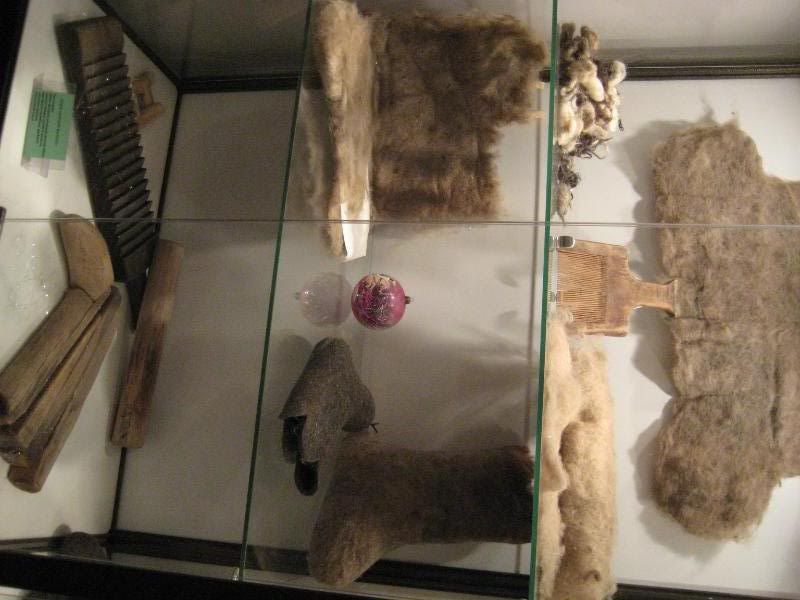





There was also not a whole lot of actual old, "traditional" valenki. We were told that very few examples survive thanks to moths, etc. I should point out that Russian curators and archivists, in my experience, have a different idea of what's worth displaying and what isn't. I wouldn't be surprised at all if they had a ton of old valenki that were fascinating for their structure or for the techniques used, which they would never consider displaying either because they have a few moth holes or because they're not particularly heavily decorated. Sigh. Anyway. Here are the only examples of "old" valenki from the exhibit (no dates were offered):



This one appears to have been decorated with red yarn - my guess is that the boot itself was made through felting (not fulling) like the others, then the design was sewn/embroidered on with red yarn, then they were felted a little further. But I'm just guess from looking at it closely.
These are a cool idea!

The rest of the exhibit consisted of perfectly new valenki that were decorated in a variety of ways. I'll be honest - I thought nearly every single pair was hideously ugly. However, the techniques used to make or decorate them are fascinating. Take the basic idea of felting rough raw wool into a foot shape or fabric as common to all, on top of that base nearly every fiber technique I can think of was used in one way or another to elaborate on or decorate that basic idea:










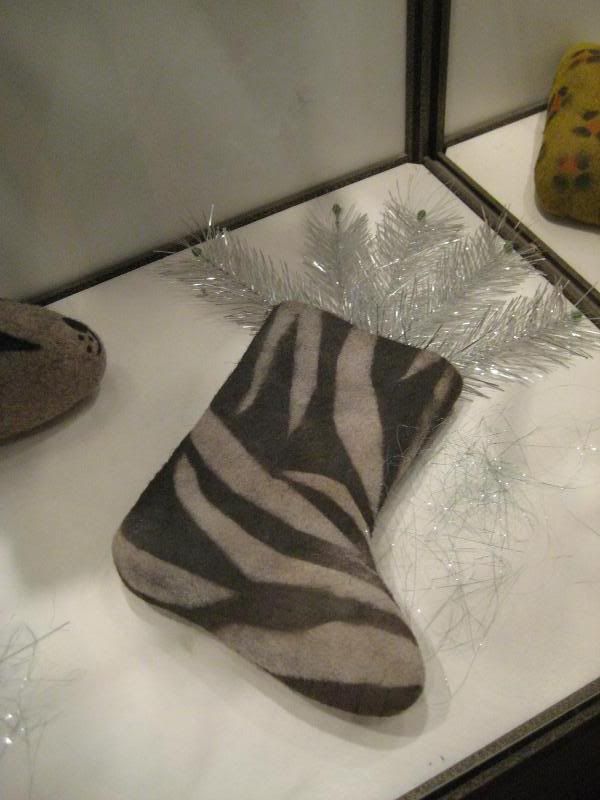











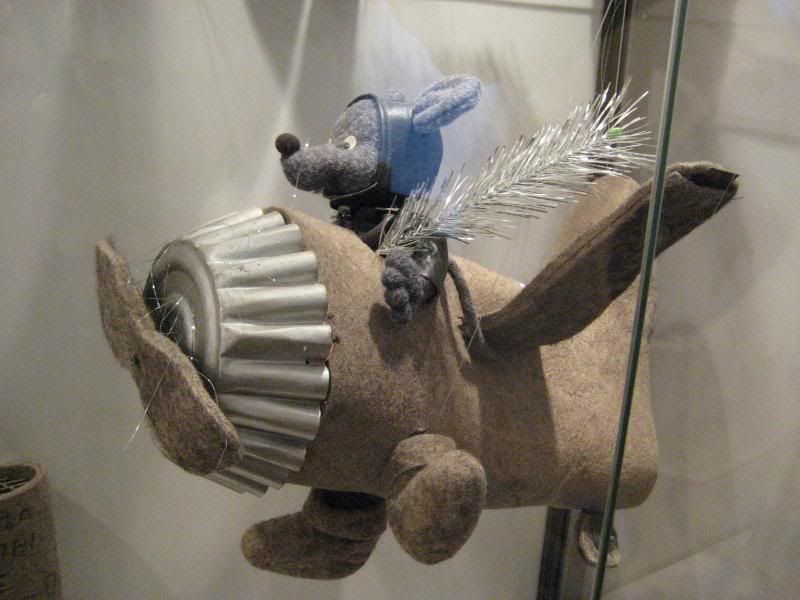


In addition (actually it was probably the point of the exhibit), they had some other valenki available for sale. These were made at factories in other towns, and I absolutely plan on visiting those factory stores at some point (though it probably won't be soon). The ones they had here were very pricey, especially the (much prettier) handmade ones, and we just couldn't afford them right now. Maybe next time. Here are a pair of the very beautiful handmade ones:

We did buy a pair of the cheapest kind, which are machine-made and not as pretty, but the two very thick, hard, solid layers of felt for the soles are impressively sturdy and warm:

I'm obsessed with the search for ever thicker layers of wool to put between the soles of my feet and the cold floors of our apartment. I've been wearing these non-stop since we bought them, and I've very satisfied!
I'm out of gas now (after an afternoon of wrestling with the camera, photos, etc), but just wanted to say - thank you all for your wonderful comments and congratulations! There were various questions which I'm not ignoring (or rather, not planning to ignore forever) - will try to address some of those next time, along with some other fun things I have in mind....Anyway, you guys are the best, thank you!
The key point is that we finally made it there again, and they were open this time!
So what the heck am I talking about?
Valenki!
What the heck are valenki?
Traditional Russian felted boots (or slippers). These are truly felt, not fulling - they're not knitted, then shrunk. Raw wool is felted directly onto a foot-shaped mold using soap, water, and apparently a wooden washboard type thingy for agitation. Also (and this was news to me) the word can also be used for the kind of footwear made when wool is pressed into flat felt and then sewn together to form boots or slippers.
The wool in question is *very* rough - much rougher than any of the wool we would use for knitting. It feels like rug wool or perhaps rougher. It's very thick - the finished felt I saw was thicker than a quarter inch, but slightly less than a full centimeter (of course I measured - wouldn't you?).
The exhibit was put on by the "Museum of Russian Valenki" which has a website here (Russian language only, but there's an online gallery here). The exhibit I saw was in a different location than what is apparently their physical museum, and was very low on explanatory information, but at least they were really nice about letting me take pictures! And the one display showing tools was sufficient to confirm what little I did know about methods:
(as always, click for bigger)






There was also not a whole lot of actual old, "traditional" valenki. We were told that very few examples survive thanks to moths, etc. I should point out that Russian curators and archivists, in my experience, have a different idea of what's worth displaying and what isn't. I wouldn't be surprised at all if they had a ton of old valenki that were fascinating for their structure or for the techniques used, which they would never consider displaying either because they have a few moth holes or because they're not particularly heavily decorated. Sigh. Anyway. Here are the only examples of "old" valenki from the exhibit (no dates were offered):



This one appears to have been decorated with red yarn - my guess is that the boot itself was made through felting (not fulling) like the others, then the design was sewn/embroidered on with red yarn, then they were felted a little further. But I'm just guess from looking at it closely.
These are a cool idea!

The rest of the exhibit consisted of perfectly new valenki that were decorated in a variety of ways. I'll be honest - I thought nearly every single pair was hideously ugly. However, the techniques used to make or decorate them are fascinating. Take the basic idea of felting rough raw wool into a foot shape or fabric as common to all, on top of that base nearly every fiber technique I can think of was used in one way or another to elaborate on or decorate that basic idea:

























In addition (actually it was probably the point of the exhibit), they had some other valenki available for sale. These were made at factories in other towns, and I absolutely plan on visiting those factory stores at some point (though it probably won't be soon). The ones they had here were very pricey, especially the (much prettier) handmade ones, and we just couldn't afford them right now. Maybe next time. Here are a pair of the very beautiful handmade ones:

We did buy a pair of the cheapest kind, which are machine-made and not as pretty, but the two very thick, hard, solid layers of felt for the soles are impressively sturdy and warm:

I'm obsessed with the search for ever thicker layers of wool to put between the soles of my feet and the cold floors of our apartment. I've been wearing these non-stop since we bought them, and I've very satisfied!
I'm out of gas now (after an afternoon of wrestling with the camera, photos, etc), but just wanted to say - thank you all for your wonderful comments and congratulations! There were various questions which I'm not ignoring (or rather, not planning to ignore forever) - will try to address some of those next time, along with some other fun things I have in mind....Anyway, you guys are the best, thank you!
10 January 2008
3 FOs and a JOB!
How's that for accomplishment? Okay, it helps that I've been waiting huge amounts of time between posts, and yes, of course two of the FOs had been languishers that I just finished up, but...3 FOs and a job! And pictures! (we finally got a few sunny days in a row...we paid the price of -18C temps, but it was worth it)
So - first things first. The sweaters.
No, okay, I'm kidding. As enamored as I am of the sweaters, I want to tell you about the job first!
I got one! That's the most significant, shocking, unbelievably fact at the moment. Now, I know several of you are poised to go comment something really sweet about how I shouldn't be shocked, I worked hard, etc, but the academic job market is really arbitrary and I know many incredibly talented and hard-working people who end up sh@t out of luck year after year, stuck in cycles of incredibly low-paying adjuncting or whatever. I fully expected to put my time in with this, and see whether it would eventually lead to a tenure-track job or to leaving academia after about 5 years or so. But, I've been very, unexpectedly lucky. I'm in a relatively tiny field - though there are many more jobs for Americanists, for example, there's also way more Americanists than there are jobs. Not as many colleges have even one Russianist in their departments, but then again there are only a tiny handful of PhD Programs producing Russianists, and there have been fewer and fewer going through that system since 1992ish. Meanwhile, apparently that magical moment when the professoriate hired in the early 60s retires has finally hit (10-15 years later than expected) and trickled down - there were an unprecedented number of openings in my field this year. Like, several times more than last year, which had been a good year. So I got 5 preliminary interviews, which is awesome, but not completely out of the question since there are probably 25-30 Russianists applying at most (more likely less), as opposed to the 250 who apply for most Europeanist positions.
One of the schools that offered me an interview actually bypasses a large part of the usual process (usual being two levels of interviewing: preliminary conference interviews and intense on-campus visits), and gave me an on-campus interview in mid-December. I just found out that they've offered me a tenure-track job, even before learning whether I even made it as a finalist for the others. Luckily, as it happens, it was a really easy decision to just accept it and be done. This school solves all kinds of practical (geographic) problems for us, since we can stay in NYC where Hubbster is committed for another year, and is a good school that impressed the heck out of me on my visit, with some really lovely people whom I genuinely liked. Again - more tremendous luck.
Oh, but you wanted to hear about the sweaters? Here are the sweaters (all photos, click for slightly bigger):
Hubbster's Dutch Fisherman's Sweater. Here's the Ravelry page on it. (If you're not on Ravelry yet and you care about knitting enough to read this blog at all, you should sign up right now - these days they're moving through the waiting list very quickly and it only takes 1-2 weeks.)
After leaving it untouched through all the crazy traveling and stress of last summer and fall, I finally got back to it in these last couple of weeks while I was suffering fromcold/flu plague and had lots of time sitting in a chair because if I had lain down I would have choked to death on my own phlegm.
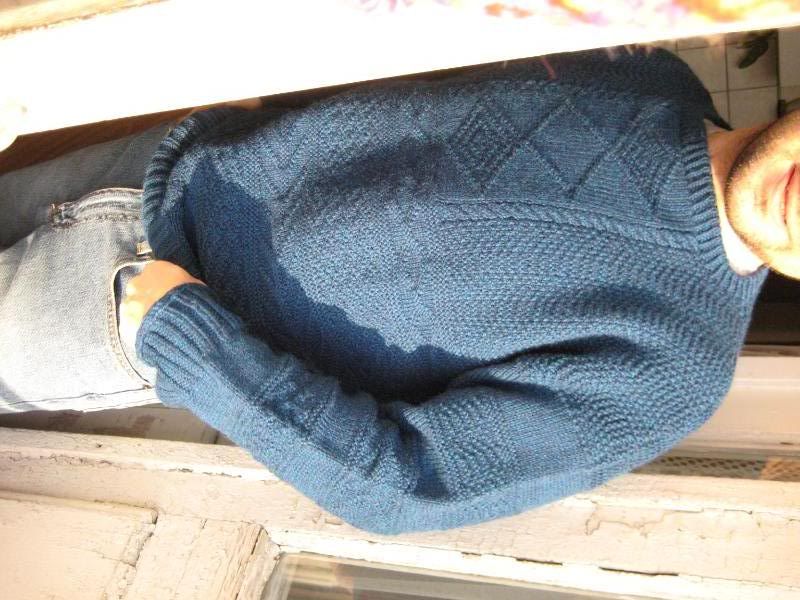
This is the only outdoor picture, sadly, because it was -18C.


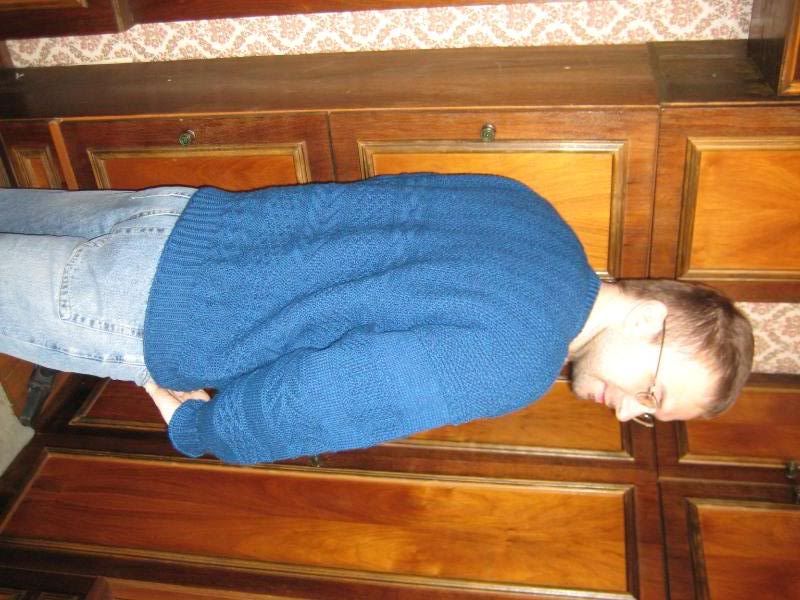
The color - KnitPicks WotA Sapphire Heather - never ceases to fascinate me. Gorgeous. Feels sturdy and durable but soft enough for comfort over just a t-shirt (I did it on US5, so it's fairly dense). Hubbster assures me that the color and feel strike an appropriate balance between attractiveness and manliness (Hubbster would also like to hereby be known as "Hubbus" as he thinks this is more manly sounding than Hubbster but I'm not sure I'll remember).
The knitting of it was easily the smoothest and most trouble-free of my sweater career. I did mis-calculate the frequency of increases on the first sleeve (inevitable) but practice at this particular mistake made me catch it quickly. For once the collar came out just right on the first try. The pattern was very easy - it looks more complicated than it is, but each row-pattern is easy to memorize and predictable. I made the first sleeve too short at first, but instead of ripping all of it I snipped one row in the plain stockinette portion at the top, added the necessary 5 extra rows, then grafted it back together. Doesn't show a bit. After blocking I added a few rows to each cuff, also - it was hard to predict how much it would flatten out, but luckily this was as much adjusting as I needed to do. The drop sleeves have surprisingly little extraneous bulk. My favorite detail is the I-cord CO/BO on the hem and cuffs. I saw something like that in the historical pics in the book, though it's not mentioned in the actual pattern (not sure if the original was I-cord or just rolled reverse stockinette, though).
The next sweater is not as much of an unmitigated joy, but I'm sure happy it's done!
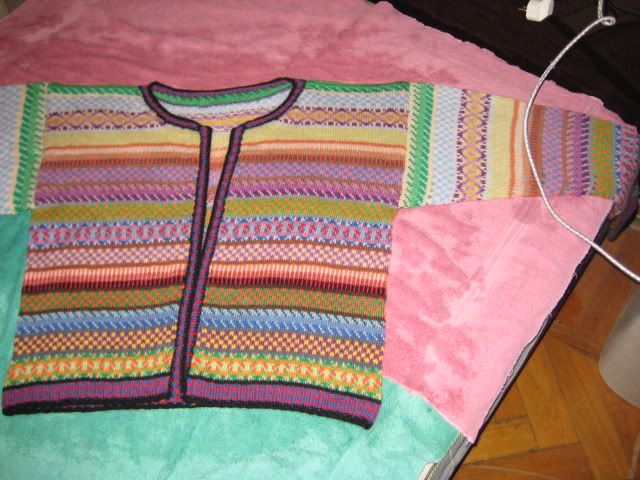

It's the KnitPicks Palette Sample Cardigan, at long, long last. Here's the Ravelry page. It had sat in my knitting bag awaiting the cutting of the front and collar steeks for an embarrassingly long time. Beth had even volunteered to do it for me over the summer, but I stupidly forgot to bring it with me to the Allegan Fiber Festival. The truth is, I was both terrified of cutting (the collar, specifically, since the steek was sloped - the sleeve experience had made me a little more sanguine about straight steeks) and had also lost some of my love for the sweater after realizing that switching needles on the second sleeve had made it slightly larger than the other. And with all those tiny bits of different colored yarns, I wasn't about to frog. No way, Dude. So I pretty much resigned myself to having a very beautiful only-around-the-house sweater and I just wasn't that pumped about it anymore.
But, in the euphoria over finishing the Dutch Fisherman's Sweater, I did it. The cutting wasn't that bad, as advertised - actually kind of fun once I'd decided I wasn't that happy with how the sweater was turning out anyway! And I'm not totally unhappy, either - this project was meant to be a learning experience, and I did learn from it everything I'd intended to learn. And, I have a delicious sweater for wearing at home, which I actually needed. I seldom knit cardigans (have I ever, before? I don't think so, actually), but they're really the only kind of sweaters I want to wear indoors. And the Palette yarn is astonishingly soft and pleasant to the touch. And I have oodles of lovely leftovers to play with.
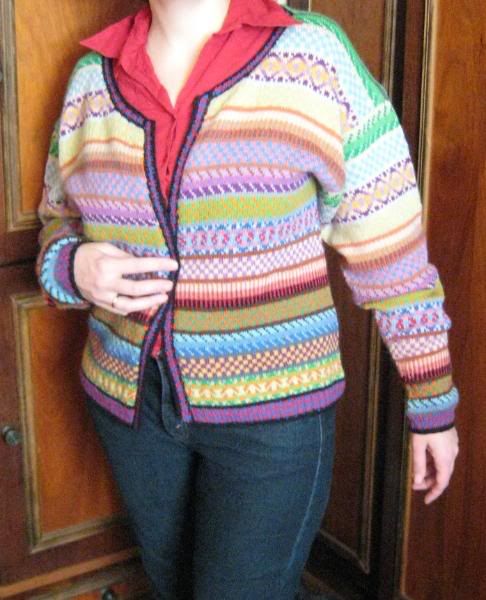
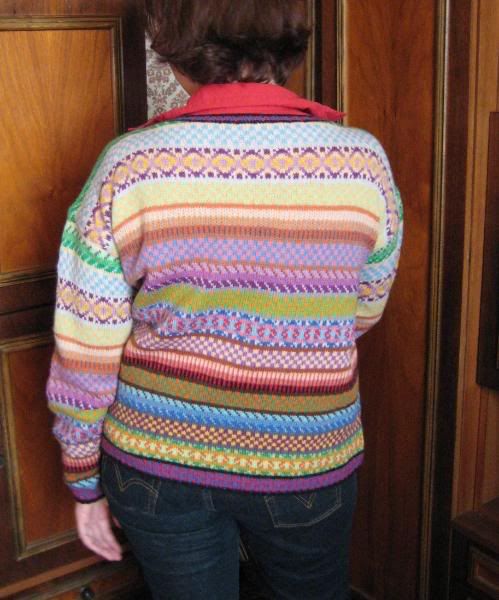
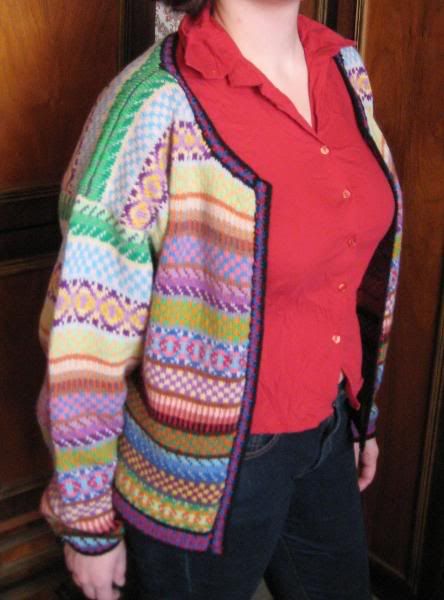
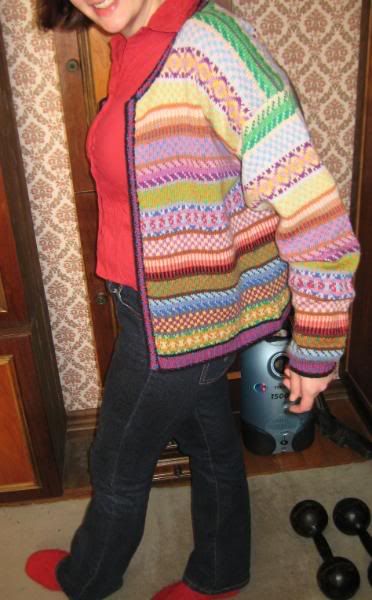
Notice how I have cleverly staged these photos to keep you from noticing how severely the sleeve dimensions don't actually match? Actually, after blocking, that's the least of my problems with the sleeves. What I like least is the hugeness of them both at the top - which was strictly according to the pattern. I know it's a drop-sleeve design, but this is out of control. Now I know to always modify this (I think I already knew that, but I ignored the Little Voice). It's also a little too short, which was my fault, but I'm glad that it ended with my favorite motif - the one with the three graduated shades of green - at the top of the body and sleeves, where they're prominent.
While the sweaters blocked, I quickly whipped up a tea cozy to match the Garter Mug Cozies I made from the IK pattern in the holiday special issue that I picked up while I was in NYC for my interview.
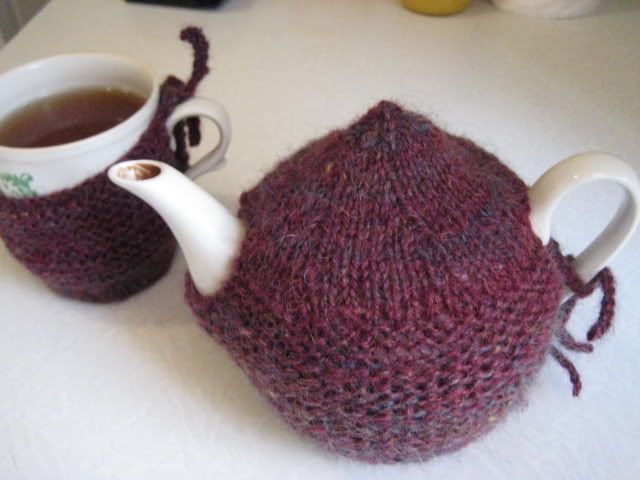
Simply because our tea was getting cold. Problem solved, with modest aesthetic pleasure as pure bonus. I used my own handspun (!!) - it was the roving I bought together with my PeaceFleece spindle from an LYS on Long Island, because the other fiber I had collected at that point was still out of reach in my suitcase in NYC. It's Corriedale/Romney and I love the dye job - absolutely delicious - but I wasn't happy with the condition of the fiber once I actually got into spinning it. It had lots of little pills in it, as if it had been handled too much or badly or something. I don't know enough to say why, but I do know that it led to much bumpier and less fun spinning than other fibers I was spinning at the same time. Compared to the awesome, shiny, blissfully pleasant spinning experience and final product of the Wensleydale that Beth sent me (and which I dyed myself with kool-aid) - well. Let's just say, I vow to always, always listen to Beth about all things fibery and not stray again any time soon no matter what. I also vow to go back to Beth's shop this coming summer and buy myself a fiber stash so that I'm never in such dire straits again - hey, I'll be employed by then! And while I'm there, if I take the opportunity to try out all the spinning wheels...well, who could possibly blame me?
As if this post isn't long enough already, I don't want to leave without sharing some of the pictures I've been assiduously taking.
First there's the pretty:
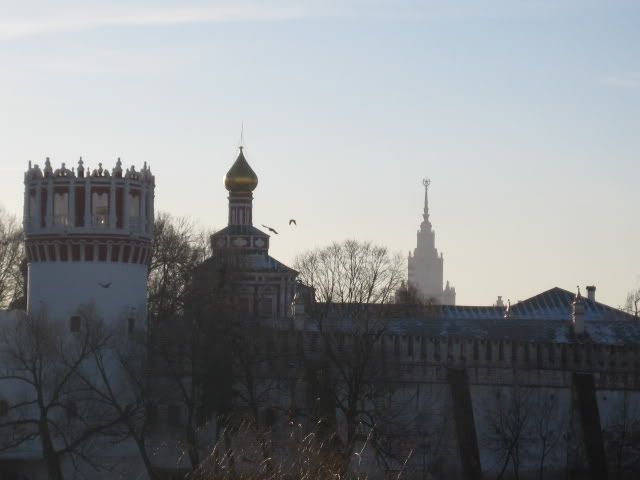


(From a monastery located right in the middle of the city, within walking distance from us)
And then there's the more neighborhoody sort of sights:
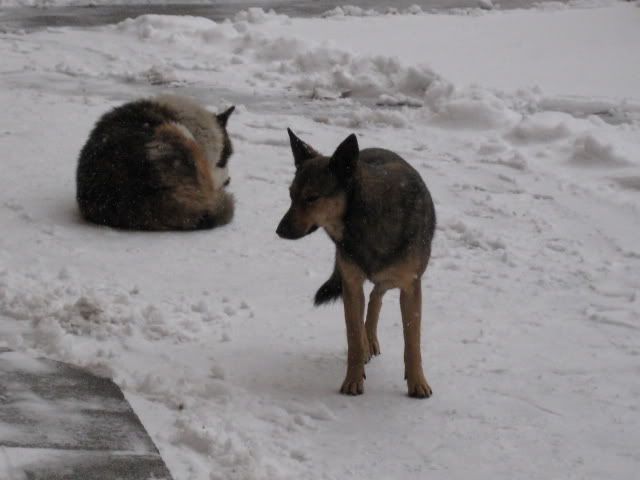
(stray dogs)

(can you guess what year this playground was built?)

(Sadly, much of our snow melted after I took these pictures, then we hit this cold snap, and all it did was freeze the dog pee on the sidewalks.)
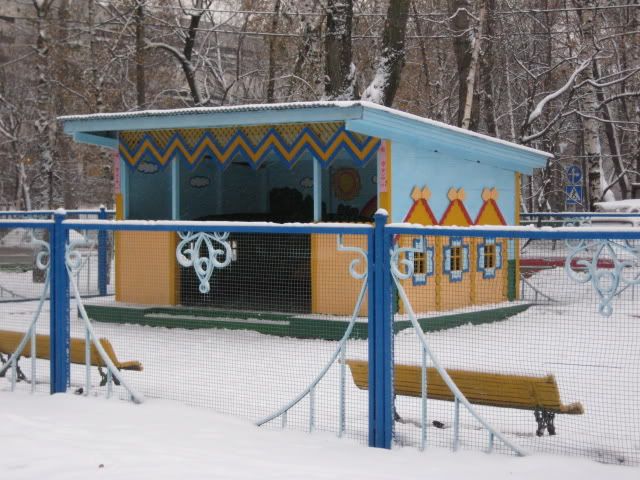
(I don't really know the purpose of this thing, but there are several of them around the playgrounds in the neighborhood, each one striving to be cuter than the next.)

("New Years" decorations at the nearby baked goods kiosk)
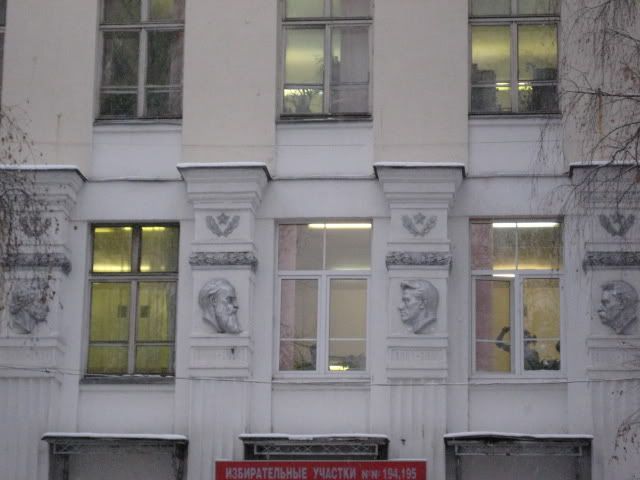
(These relief portraits are on a local school. My first thought was that the guy on the far right was Stalin. Which seemed strange, but I thought the guy at middle left could be Marx. Which leaves, of course, Lenin and Engels, but that would mean the artist was singularly untalented. A closer look made it clear - from L to R they're: Pushkin, Tolstoy, Mayakovsky and Gorky. That's more like it!)
I thought I had a picture of the cars triple-parked all over the sidewalks, but I can't find it, so that'll have to end our tour for today. Hope you enjoyed!
So - first things first. The sweaters.
No, okay, I'm kidding. As enamored as I am of the sweaters, I want to tell you about the job first!
I got one! That's the most significant, shocking, unbelievably fact at the moment. Now, I know several of you are poised to go comment something really sweet about how I shouldn't be shocked, I worked hard, etc, but the academic job market is really arbitrary and I know many incredibly talented and hard-working people who end up sh@t out of luck year after year, stuck in cycles of incredibly low-paying adjuncting or whatever. I fully expected to put my time in with this, and see whether it would eventually lead to a tenure-track job or to leaving academia after about 5 years or so. But, I've been very, unexpectedly lucky. I'm in a relatively tiny field - though there are many more jobs for Americanists, for example, there's also way more Americanists than there are jobs. Not as many colleges have even one Russianist in their departments, but then again there are only a tiny handful of PhD Programs producing Russianists, and there have been fewer and fewer going through that system since 1992ish. Meanwhile, apparently that magical moment when the professoriate hired in the early 60s retires has finally hit (10-15 years later than expected) and trickled down - there were an unprecedented number of openings in my field this year. Like, several times more than last year, which had been a good year. So I got 5 preliminary interviews, which is awesome, but not completely out of the question since there are probably 25-30 Russianists applying at most (more likely less), as opposed to the 250 who apply for most Europeanist positions.
One of the schools that offered me an interview actually bypasses a large part of the usual process (usual being two levels of interviewing: preliminary conference interviews and intense on-campus visits), and gave me an on-campus interview in mid-December. I just found out that they've offered me a tenure-track job, even before learning whether I even made it as a finalist for the others. Luckily, as it happens, it was a really easy decision to just accept it and be done. This school solves all kinds of practical (geographic) problems for us, since we can stay in NYC where Hubbster is committed for another year, and is a good school that impressed the heck out of me on my visit, with some really lovely people whom I genuinely liked. Again - more tremendous luck.
Oh, but you wanted to hear about the sweaters? Here are the sweaters (all photos, click for slightly bigger):
Hubbster's Dutch Fisherman's Sweater. Here's the Ravelry page on it. (If you're not on Ravelry yet and you care about knitting enough to read this blog at all, you should sign up right now - these days they're moving through the waiting list very quickly and it only takes 1-2 weeks.)
After leaving it untouched through all the crazy traveling and stress of last summer and fall, I finally got back to it in these last couple of weeks while I was suffering from

This is the only outdoor picture, sadly, because it was -18C.



The color - KnitPicks WotA Sapphire Heather - never ceases to fascinate me. Gorgeous. Feels sturdy and durable but soft enough for comfort over just a t-shirt (I did it on US5, so it's fairly dense). Hubbster assures me that the color and feel strike an appropriate balance between attractiveness and manliness (Hubbster would also like to hereby be known as "Hubbus" as he thinks this is more manly sounding than Hubbster but I'm not sure I'll remember).
The knitting of it was easily the smoothest and most trouble-free of my sweater career. I did mis-calculate the frequency of increases on the first sleeve (inevitable) but practice at this particular mistake made me catch it quickly. For once the collar came out just right on the first try. The pattern was very easy - it looks more complicated than it is, but each row-pattern is easy to memorize and predictable. I made the first sleeve too short at first, but instead of ripping all of it I snipped one row in the plain stockinette portion at the top, added the necessary 5 extra rows, then grafted it back together. Doesn't show a bit. After blocking I added a few rows to each cuff, also - it was hard to predict how much it would flatten out, but luckily this was as much adjusting as I needed to do. The drop sleeves have surprisingly little extraneous bulk. My favorite detail is the I-cord CO/BO on the hem and cuffs. I saw something like that in the historical pics in the book, though it's not mentioned in the actual pattern (not sure if the original was I-cord or just rolled reverse stockinette, though).
The next sweater is not as much of an unmitigated joy, but I'm sure happy it's done!


It's the KnitPicks Palette Sample Cardigan, at long, long last. Here's the Ravelry page. It had sat in my knitting bag awaiting the cutting of the front and collar steeks for an embarrassingly long time. Beth had even volunteered to do it for me over the summer, but I stupidly forgot to bring it with me to the Allegan Fiber Festival. The truth is, I was both terrified of cutting (the collar, specifically, since the steek was sloped - the sleeve experience had made me a little more sanguine about straight steeks) and had also lost some of my love for the sweater after realizing that switching needles on the second sleeve had made it slightly larger than the other. And with all those tiny bits of different colored yarns, I wasn't about to frog. No way, Dude. So I pretty much resigned myself to having a very beautiful only-around-the-house sweater and I just wasn't that pumped about it anymore.
But, in the euphoria over finishing the Dutch Fisherman's Sweater, I did it. The cutting wasn't that bad, as advertised - actually kind of fun once I'd decided I wasn't that happy with how the sweater was turning out anyway! And I'm not totally unhappy, either - this project was meant to be a learning experience, and I did learn from it everything I'd intended to learn. And, I have a delicious sweater for wearing at home, which I actually needed. I seldom knit cardigans (have I ever, before? I don't think so, actually), but they're really the only kind of sweaters I want to wear indoors. And the Palette yarn is astonishingly soft and pleasant to the touch. And I have oodles of lovely leftovers to play with.




Notice how I have cleverly staged these photos to keep you from noticing how severely the sleeve dimensions don't actually match? Actually, after blocking, that's the least of my problems with the sleeves. What I like least is the hugeness of them both at the top - which was strictly according to the pattern. I know it's a drop-sleeve design, but this is out of control. Now I know to always modify this (I think I already knew that, but I ignored the Little Voice). It's also a little too short, which was my fault, but I'm glad that it ended with my favorite motif - the one with the three graduated shades of green - at the top of the body and sleeves, where they're prominent.
While the sweaters blocked, I quickly whipped up a tea cozy to match the Garter Mug Cozies I made from the IK pattern in the holiday special issue that I picked up while I was in NYC for my interview.

Simply because our tea was getting cold. Problem solved, with modest aesthetic pleasure as pure bonus. I used my own handspun (!!) - it was the roving I bought together with my PeaceFleece spindle from an LYS on Long Island, because the other fiber I had collected at that point was still out of reach in my suitcase in NYC. It's Corriedale/Romney and I love the dye job - absolutely delicious - but I wasn't happy with the condition of the fiber once I actually got into spinning it. It had lots of little pills in it, as if it had been handled too much or badly or something. I don't know enough to say why, but I do know that it led to much bumpier and less fun spinning than other fibers I was spinning at the same time. Compared to the awesome, shiny, blissfully pleasant spinning experience and final product of the Wensleydale that Beth sent me (and which I dyed myself with kool-aid) - well. Let's just say, I vow to always, always listen to Beth about all things fibery and not stray again any time soon no matter what. I also vow to go back to Beth's shop this coming summer and buy myself a fiber stash so that I'm never in such dire straits again - hey, I'll be employed by then! And while I'm there, if I take the opportunity to try out all the spinning wheels...well, who could possibly blame me?
As if this post isn't long enough already, I don't want to leave without sharing some of the pictures I've been assiduously taking.
First there's the pretty:



(From a monastery located right in the middle of the city, within walking distance from us)
And then there's the more neighborhoody sort of sights:

(stray dogs)

(can you guess what year this playground was built?)

(Sadly, much of our snow melted after I took these pictures, then we hit this cold snap, and all it did was freeze the dog pee on the sidewalks.)

(I don't really know the purpose of this thing, but there are several of them around the playgrounds in the neighborhood, each one striving to be cuter than the next.)

("New Years" decorations at the nearby baked goods kiosk)

(These relief portraits are on a local school. My first thought was that the guy on the far right was Stalin. Which seemed strange, but I thought the guy at middle left could be Marx. Which leaves, of course, Lenin and Engels, but that would mean the artist was singularly untalented. A closer look made it clear - from L to R they're: Pushkin, Tolstoy, Mayakovsky and Gorky. That's more like it!)
I thought I had a picture of the cars triple-parked all over the sidewalks, but I can't find it, so that'll have to end our tour for today. Hope you enjoyed!
Labels:
accessories,
Fair Isle,
FO,
non-knitting-content,
spinning,
sweater,
travel
Subscribe to:
Comments (Atom)




















